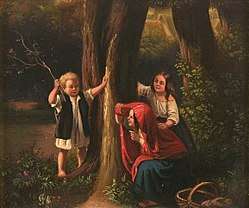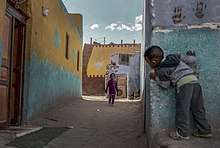Hide-and-seek
Hide-and-seek is a popular children's game in which at least two players (Usually at least three)[1] conceal themselves in a set environment, to be found by one or more seekers. The game is played by one player chosen (designated as being "it") closing their eyes and counting to a predetermined number while the other players hide. After reaching this number, the player who is "it" calls "Ready or not, here I come!" or "Coming, ready or not!" and then attempts to locate all concealed players.[2]
 A 19th-century painting of three children playing hide and seek in a forest (Friedrich Eduard Meyerheim) | |
| Players | 2+ |
|---|---|
| Setup time | about 90 seconds |
| Playing time | no limit |
| Random chance | Very low |
| Age range | 3+ |
| Skill(s) required | Running, tracking, hiding, observation, ability to stay silent |
The game can end in one of several ways. the most common way of ending is the player chosen as "it" locates all players; the player found first is the loser and is chosen to be "it" in the next game. The player found last is the winner. Another common variation has the seeker counting at "home base"; the hiders can either remain hidden or they can come out of hiding to race to home base; once they touch it, they are "safe" and cannot be tagged. In Ohio, a hider must yell "free" when he touches base or he can still be tagged out. But if the seeker tags another player before reaching home base, that person becomes "it", or "the seeker".
The game is an example of an oral tradition, as it is commonly passed by children.
Variants

Different versions of the game are played around the world, under a variety of names.[3]
One variant is called "Sardines", in which only one person hides and the others must find them, hiding with them when they do so. The hiding places become progressively more cramped, like sardines in a tin. The last person to find the hiding group is the loser, and becomes the hider for the next round. A. M. Burrage calls this version of the game "Smee" in his 1931 ghost story of the same name.[4]
_by_William_Bliss_Baker.jpg)
In some versions of the game, after the first hider is caught or if no other players can be found over a period of time, the seeker calls out a previously-agreed phrase (such as "Olly olly oxen free", or "All in, All in, Everybody out there all in free") to signal the other hiders to return to base for the next round.[5] In another version, when hiders are caught they help the seeker locate the remaining hiders.
In one variant, once all hiders have been located, the game then becomes a game of tag where the seeker chases after all the other players and the first person tagged becomes the seeker for the next round.
In another, the hiders who are found help the seeker track down the remaining hiders, but the first person to be found becomes the next seeker.
In another variant the game is called "Chase". It is team-based and plays only after dusk. Two teams—the hiders and the seekers—are each composed of two or more players. There is a central home base (a.k.a safe) from which the seekers count and hiders must return to without being tagged by a seeker in order to be considered "free" to hide again. All players dress in black. No flashlights are allowed. The only lights in the playing field are those from street lamps or natural lighting. The goal is for the hiders to take advantage of camouflage of the shadows in the surrounding area. The game is meant to be stealth. When a hider is caught—tagged by a seeker—the hider does not get to hide again and must remain on home base. If a hider returns home "free" without being tagged they can hide again in the next round representing their team. When all hiders are caught then the hiders become the seekers and the seekers become the hiders. Hiders cannot leave the boundaries of the playing field or else are immediately "caught" or "out" from the round. The origins of this version arose in Greece, New York, in 1976 and had a large following through the end of 1989. Its popularity waned in the 1990s as parents began worrying about adolescent safety at night.
In some parts of Australia, the game is called "44 Homes". The hiders hide until they are spotted by the seeker, who chants, "Forty, forty, I see you" (sometimes shortened to "Forty, forty, see you"). Once spotted, the hider must run to "home base" (where the seeker was counting while the other players hid) and touch it before they are "tipped" (tagged, or touched) by the seeker. If tagged, that hider becomes the new seeker.[6]
In North India, hide-and-seek is played differently—if any of the hiders touch the seeker and says "Dhappa" without being spotted, then the seeker has to restart the round and count again; and the seeker says "I Spies" when spotting a hider. The first hider spotted becomes the seeker for the next round. Different locations may use different phrases, such as "Chappa" and "icepies" (I spies), or alter when the seeker can be touched (e.g. during counting). The seeker is sometimes known as "Dianer" (counter).
In Brazil and Russia, when the seeker spots a hider, they both race to the spot where the seeker was originally counting; whoever touches that spot first wins the game.
Hide-and-seek is sometimes played at night in a park, a field, or a house with the lights off.
International competition
Hide and seek world championship officially named "Nascondino World Championship" is the unique international hide-and-seek competition, a team play for adults, with non-diversified categories by gender. Born in 2010 in the Italian city of Bergamo, it is held annually in Italy, in summer. The game is a derivative of the Italian version of hide and seek, "nascondino" (hide-and-seek in Italian), and takes place on a playground in the open air, set up with artificial and natural hideouts. The seventh competition took place in September 2017, with 70 teams from 11 countries.
See also
- Princess and monster game
- Search game
- Sepak Tekong
References
- Williams, Jenny (20 August 2009). "30 Classic Outdoor Games for Kids". Wired. Hide and Seek. Retrieved 2 July 2017.
- Trafton, J. Gregory; Schultz, Alan; Perznowski, Dennis; Bugajska, Magdalena; Adams, William; Cassimatis, Nicholas; Brock, Derek (August 2003). "Children and robots learning to play hide and seek" (PDF). Naval Research Laboratory. Retrieved December 2, 2011. Cite journal requires
|journal=(help) - "hide-and-seek". Encyclopædia Britannica, Inc. Retrieved 22 December 2012.
- The Oxford Book of English Ghost Stories, OUP 1986.
- Ollie Ollie oxen free, World Wide Words, Michael Quinion
- Darian-Smith K, Logan W, Seal G (2011). "44 Home - Hiding Game". Childhood, Tradition and Change. Australia. Retrieved 2017-07-03.
External links
![]()